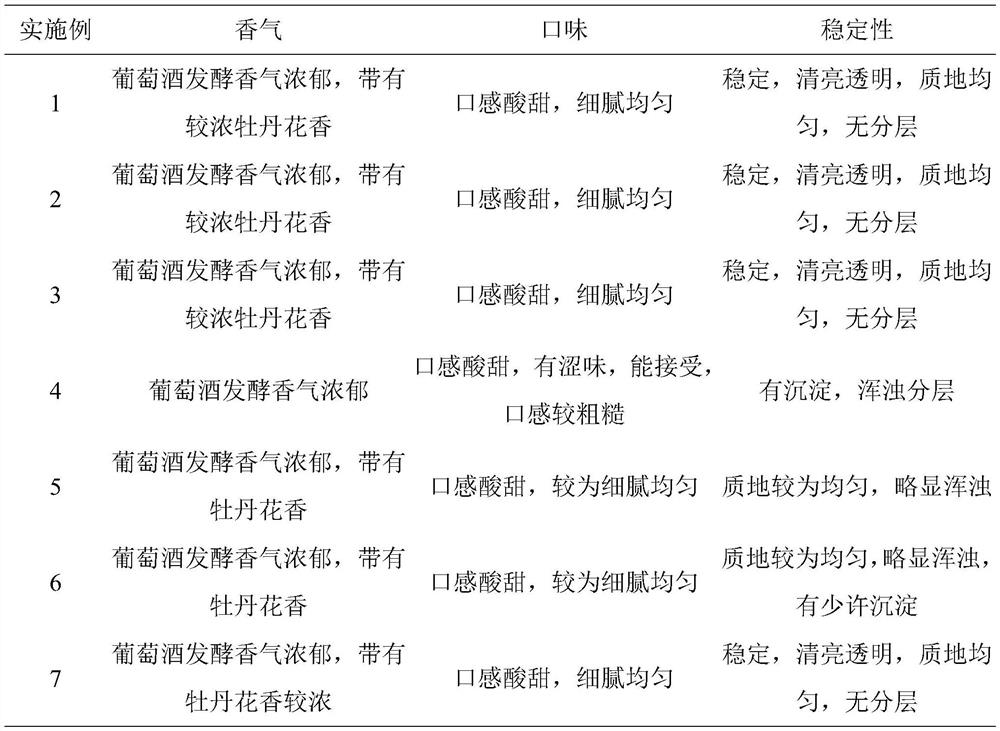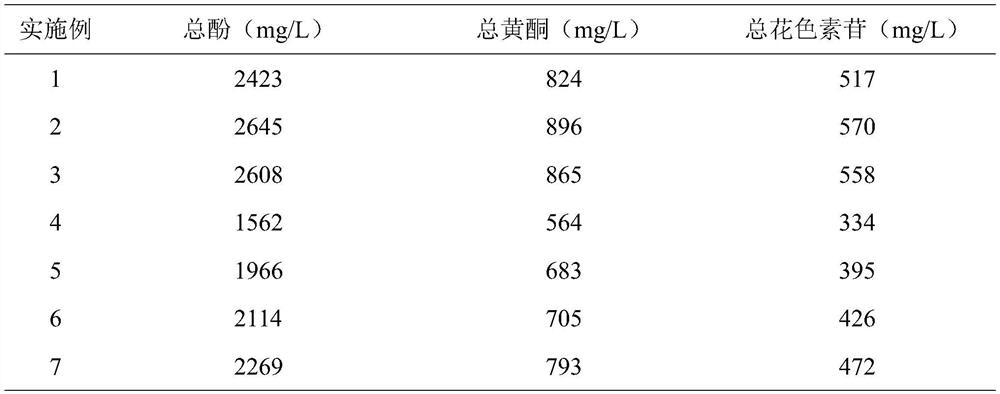Preparation process of wine
A preparation process and wine technology, which is applied in the field of wine preparation process, can solve the problems of low alcohol content and complex aroma, and achieve the effect of strong aroma, complex aroma and rich aroma substances
- Summary
- Abstract
- Description
- Claims
- Application Information
AI Technical Summary
Problems solved by technology
Method used
Image
Examples
Embodiment 1
[0032] In step S1, two kinds of grapes, Cabernet Sauvignon and Cabernet Franc, are selected, picked during the ripening period of the grapes, and mildewed and diseased fruits are removed. The selected grapes are destemmed and softly crushed. The temperature is controlled throughout the process, and the temperature is 6 ℃;
[0033] Step S2, taking 100 L of crushed red grape juice with pomace, adding 8 g of food-grade potassium metabisulfite, 2 g of pectinase, and adding 2 g of peony pollen to it to obtain grape must, and controlling the temperature to 6°C;
[0034] Step S3, immersing the grape must prepared in step S2 in a fermenter, the immersion temperature is 6°C, and taking out 10 L of clear liquid after 2 days of immersion;
[0035] Step S4, select peony petals with no damage on the surface, crush them, add 80°C hot water twice the mass of peony petals for extraction, and filter to obtain filtrate 1; filter residue is extracted again with twice the mass of 90°C hot water t...
Embodiment 2
[0040]Step S1, select Cabernet Sauvignon grapes, pick them during the ripening period of the grapes, remove mildewed and diseased fruits, remove the stems of the screened grapes, gently crush them, and control the temperature during the whole process, the temperature is 10°C;
[0041] Step S2, taking 100 L of crushed red grape juice with pomace, adding 9 g of food-grade potassium metabisulfite, 3 g of pectinase, and adding 10 g of peony pollen to it to obtain grape must, and controlling the temperature at 10°C;
[0042] Step S3, immersing the grape mash prepared in step S2 in a fermenter at a temperature of 10° C., taking out 15 L of clear liquid after 6 days of immersion;
[0043] Step S4, select peony petals with no damage on the surface, crush them, add 90°C hot water 4 times the mass of peony petals for extraction, and filter to obtain filtrate 1; filter residue is extracted again with 3 times the mass of 95°C hot water to obtain the filtrate 2; Combine filtrate 1 and filt...
Embodiment 3
[0048] In step S1, two kinds of grapes, Cabernet Sauvignon and Pinot Noir, are selected, picked during the ripening period of the grapes, and mildewed and diseased fruits are removed, and the selected grapes are destemmed and softly crushed. The temperature is controlled throughout the process, and the temperature is 8 ℃;
[0049] Step S2, taking 100 L of crushed red grape juice with pomace, adding 8.5 g of food-grade potassium metabisulfite, 2.5 g of pectinase, and 7.5 g of peony pollen to obtain grape must, and controlling the temperature at 8°C;
[0050] Step S3, immersing the grape mash prepared in step S2 in a fermenter at a temperature of 8° C., taking out 10 L of supernatant liquid after 4 days of immersion;
[0051] Step S4, select peony petals with no damage on the surface, crush them, add 85°C hot water 3 times the mass of peony petals for extraction, and filter to obtain filtrate 1; filter residue is extracted again with 3 times the mass of 95°C hot water to obtain ...
PUM
 Login to View More
Login to View More Abstract
Description
Claims
Application Information
 Login to View More
Login to View More - R&D
- Intellectual Property
- Life Sciences
- Materials
- Tech Scout
- Unparalleled Data Quality
- Higher Quality Content
- 60% Fewer Hallucinations
Browse by: Latest US Patents, China's latest patents, Technical Efficacy Thesaurus, Application Domain, Technology Topic, Popular Technical Reports.
© 2025 PatSnap. All rights reserved.Legal|Privacy policy|Modern Slavery Act Transparency Statement|Sitemap|About US| Contact US: help@patsnap.com


